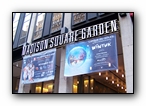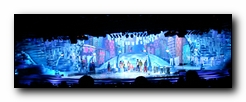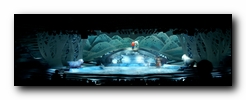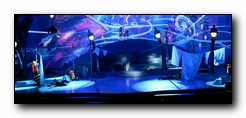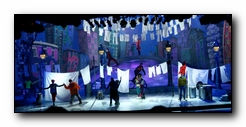
![]()
[ You are here: Grand Chapiteau | Creations | Wintuk | Scénographie ]
Création
Expérience
RéserveOdyssey
Moving closer to center stage from the extreme right and left, there are side entrances that culminate in slides, leading to the central playing area; these are for the many inline skaters in the cast. Located upstage center is a hill with a built-in ramp, also used by the skaters. The front of the stage center area moves forward, opening upto reveal a pair of pits; located in them are the puppeteers who manipulate the giant dogs, as well as a set of lamppost puppets — the latter slide around the stage and bend over, their lamps rotating to reveal faces with moving lips and eyelids. (The rotation is accomplished with the help of the RC4 wireless system.) The upstage centerwall of the set is a projection screen, where Francis Laporte’s images provide cityscapes and vivid night skies. When the show begins, we’re in the city; there are projections showing an urban block. Lines of laundry are hung across the stage, as various urban characters — kids, thieves, cops, bikers — bustle about. Later, Jamie is “blown” by the wind to another location in town, where he meets the dogs. Infact, he is carried by a motorized rigging system — one of four onstage — which was supplied by Stage Technologies. Kevin Taylor, of that company, calls them the “bird tracks,” as they carry large avians at one point. Each curved system is 70-feet in length and features Stage Technologies Big Tow winches, driven by a traction belt. (Stage Technologies’ trussing was supplied by Tomcat.) The show’s second half is set in a mythical Land of the North, where Inuit-style natives cavort, and the ice monsters, on two more Stage Technologies tracks, do battle. Most ofthe set pieces are replaced by white forest units, built out of a tough white fabric normally used to make temporary winter car parts. (The material was chosen because it reflects lightwell.) “One challenge was the inescapable fact that snow is white — and that was a challenge for the lighting and projection designers, too,” says Ruel. “The winter theme gave rise to new concepts and encouraged me to explore new materials and textures.” The white velvet Austrian curtain, deployed at intermission, features an ice pattern that was etched into the fabric with acid at Cirque’s headquarters, under the supervision of Mario Allard. The curtain was assembled at LESNA, from Montreal. It is driven by 15 double-lined winches provided by Stage Technologies. (The company also provided a separate winch for the strap act, in which two women fly through the air, and winches that lift a pair of icebergs in the Arctic scene.) Also, Ruel says, the scenic legs were made from a Rose Brand flame-retardant fabric, digitally printed with a stripe pattern taken from the set: “In this way, we get a better-looking link between solid pieces than with traditional velour legs.” Scenic painting was done by Universcène, also in Montreal Ruel notes the unusual fast-track schedule for Wintuk, which was conceived in November 2006. Morrisette says the biggest challenge was to quickly build a set that stood up to wear and tear from skaters and bikers while respecting Ruel’s desire for a light and airy look: “We fast-tracked theproject by testing components and delivering the skating ramps before therest of the set, to allow them to rehearse those scenes.”
On one point, however, everyone was clear: the design should represent a child’s-eye view of the world. Francis Laporte, projection designer, echoes this theme. “The first part of the show is more realistic — but twisted, to make a kind of hand-crafted look that is very childlike. I had a kid two years ago, and he was a big inspiration during this process. I also looked at many children’s books. There is a bienniale held in Bologna of such illustrations, and I took much inspiration from it.” For example, the first streetscape we see is a fairly realistic representation of a series of buildings — except for the funny perspective and whimsical exterior treatments, as if each building had wallpaper on the outside. Each of Laporte’s images is kinetic; as night falls, we see lights come on in the buildings, and clouds and stars pass by overhead. Later,there is a kind of rounded cityscape with many kinetic touches. Laporte’s imagery evokes many of the great children’s authors — one sees a hint of Dr. Seuss here, and a bit of Maurice Sendak there. In the second half, the imagery is far more abstract, including vividly colored Arctic skies. The majority of the projections are seen on the upstage screen. However, there is a second set of images used in an entirely different, and beguiling, way: Jamie keeps seeing the shadow of the girl who constantly eludes him. The image appears all over the set, a tone point leaping from one item to another on the laundry line. The projections are delivered by Christie projectors — 12 Roadster HD+20Ks dedicated to the upstage screen, with Roadie HD+25Ks for the Shadow Girl and some incidental effects. The upstage screen is dividedinto six sections, with two projectors per section. The images are driven by ten Green Hippo Hippotizers, chosen by Laporte for their real-time features,including their ability to performcolor correction. Laporte worked closely with Yves Aucoin, the lighting designer, to coordinate the lighting and images. “I never use the lighting operator to deliver the projections,” he said. “I come more from a tradition of theatre and opera, where the control is separate. ”The Hippotizers are controlled by Zookeeper, a control software complete with graphical user interface, developed by Green Hippo; it allows one to build an infinite number of linkable timelines to control all the Hippotizers over the network. The theatre’s wide span posed some sightline challenges. “We did what was possible with the theatre, maximizing our angles as best we could.” Laporte adds that, by and large, the images can be seen by virtually the entire audience. (The screen was supplied by LESNA; projection gear was supplied by Solotech.) Like Laporte, Aucoin chose to make the set work for him. Thus, he says, “I’m using a lot of colder shades, working bounce light and spill.” His lighting adds touches of color and warmth to the set, thanks to a palette of pastels. In the second half, there are bolder color experiments, including a version of the aurora borealis on the upstage projection screen. He adds, “This is the first time I’ve had to light puppets; it’s not easy to light a moving piece of furniture. ”He’s referring to the dogs, but the same is true of the lampposts, which also move.
Of all the members of the creative team, one would think that the sound designers, Jonathan Deans and Leon Rothenberg, would be the most affected by the room’s strange dimensions; an auditorium not well suited for less-than- conventional sound designs. "The ceiling height imposes considerable limitations on where we can fly the speakers, and how we focus them for consistent coverage across the exceptionally wide seating area,” Dean says. “However,” says Rothenberg, “The acoustics are really not so bad.” He adds that, helpfully, during show’s rehearsal process, which took place in a Montreal warehouse, the same sound system was put in place, with one exception: “We had only one surround zone there; here, at Madison Square Garden, we have six. In all other respects, the system was set up in the same way.” The two worked to create an aural experience that would embrace the young audience without overpowering it. "We wanted an enveloping sound," says Deans, "but being mindful that it's a children's production, we didn't want it to be overly loud or aggressive."On the other hand, Wintuk is an unusual challenge: a live show drivenby recorded music, with only two castmembers (Jamie and the shaman) who speak onstage. In any event, the designers have assembled a system that communicates the music’s emotional colors without being intrusive. The basic loudspeaker rig consists of 20 Meyer Sound M’elodie units, placed in four arrays of five boxes each; the units are on the small side, which make them attractive in a room with height restrictions, yet they still pack the necessary punch. "The arrays are very tightly packed, and flown as close to the ceiling as possible to keep them out of the line of sight," says Rothenberg. For the lower end, there are eight Meyer 700-HP subwoofers, hung from the ceiling. Front fill is provided by a set of seven Meyer M1Ds, placed around the frontedge of the stage, where they can feed directly into the front rows of the audience. That six-zone surround system is made up of 38 M1Ds as well. For delay in the rear of the auditorium, a dozen Meyer UPA-1Ps are implemented. (Another six UPA-1Ps are used for stage foldback, along with six Yamaha MSP5 powered monitors) In addition, ten Anchor AN1000 self-powered units were added for offstage monitoring.
Deans and Rothenberg are longtime fans of LCS control systems, and, indeed, Wintuk’s sound is controlled by the LCS CueConsole, a digital desk that is noted for its flexibility and small footprint. The music, including vocals lip-synched by the dog and lamppost puppets, is played back by a Tascam GigaStudio sampler, controlled by Ableton Live software; the computers were supplied by Rain Recording. Interestingly, Rothenberg says, “We’re still mixing the show as if it was all live music. Dan Hochstine [the production’s sound engineer] is mixing the dynamics, following the mood of the audience, and keeping track of the energy level,” a strategy that keeps the performance from seeming canned. The designers also use a T.C. Electronic M3000 reverb and five Meyer Galileo loudspeaker processors. Rothenberg says that the score, composed by Simon Carpentier, arrived in pieces, starting halfway through rehearsals. “We mixed it as it camein, adjusting the timings,” he adds. “It’s an interesting project — a recording job and a live job, too.” (Solotech supplied the sound gear. Others involved are Jake Davis, assistant designer; Jake Hall, who handles mics and wireless systems, and Fred Cantin, the system tech from Solotech.) |


